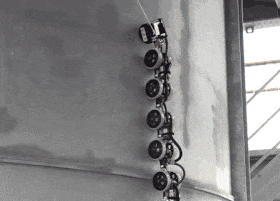Japanese engineers have developed a snake robot with magnets in the wheels. They showed how magnets hold the robot even on vertical surfaces, and the design of several segments allows it to move over obstacles. A video of the tests was published on the YouTube channel of the Nikkan Kogyo Shimbun newspaper.
One of the global goals for which engineers are developing robots and drones is to replace people with them when working in difficult and dangerous conditions. In particular, drones allow you to safely monitor, and sometimes maintain, high-rise structures, work with which always carries some risk. Most often we are talking about contactless work, although there are individual drones that can lean against vertical surfaces to, for example, measure their thickness. But drones spend a lot of energy on keeping in the air and are very limited in the mass of portable instruments and flight time.
A group of engineers led by Motoyasu Tanaka from the University of Electrical Communications has developed and tested a robot that can ride on vertical metal structures and stop without wasting energy. The robot consists of eight sections that can rotate relative to each other. The first and last sections are passive, and in the six central ones there are wheels on the surface of which neodymium magnets are installed. This allows the robot to stay on metal surfaces, and engineers note that the clamping force can be adjusted to the payload of the robot by changing the number of magnets.
The developers showed the potential use of the robot by forcing it to drive on a vertical steel tank. Before the race, the robot lifted the front part and drove even closer, and then took turns doing the same with the other sections. It is noteworthy that during the ride he was able to overcome the ledge connecting the two parts of the tank without falling down.
Earlier we talked about a robot that can walk at any angle due to suction cups. It was adapted to inspect the blades of wind turbines, which are usually inspected by people hanging on cables.
Grigory Kopiev

